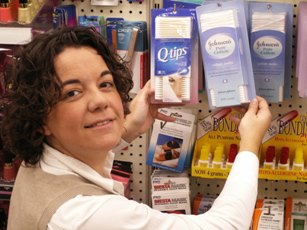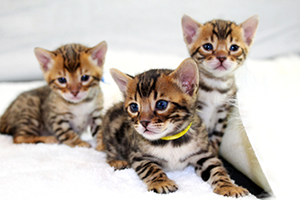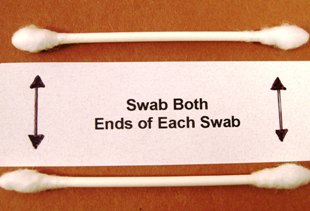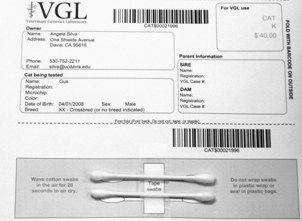Quick Summary
Click here for Price and Turnaround Time
Phenotype: Burmese head defect (BHD), or congenital frontonasal dysplasia, is characterized by improper development and subsequent malformation of the skull and facial features. Kittens with BHD may be stillborn or born live, but kittens born live cannot survive for long and require euthanasia.
Mode of Inheritance: Autosomal co-dominant
Alleles: N = Normal/Unaffected, BHD= Burmese head defect
Breeds appropriate for testing: Australian Mist, Bombay, Burmese, Burmilla, European Burmese, Tonkinese
Explanation of Results:
- Cats with N/N genoytpe will not have Burmese head defect and cannot transmit this BHD variant to any of their offspring.
- Cats with N/BHD genotype may have shortened facial structure (brachycephaly), but will not have Burmese head defect. They will transmit this BHD variant to 50% of their offspring. Matings between two N/BHD genotype cats are predicted to produce 25% kittens with Burmese head defect.
- Cats with BHD/BHD genotype will have Burmese head defect, a severe craniofacial defect that is incompatible with life.
$44 one test per animal
Also available as part of the following packages:
$66 this test + one test from list below
$88 this test + two tests from list below
$110 this test + all tests from list below
- Burmese Hypokalemia
- GM2 Gangliosidosis in Burmese
- Polycystic Kidney Disease (PKD1) (recommended for Burmilla breed)
Cat DNA tests are carried out using cells brushed from your cat's cheeks and gums using household cotton swabs.
The cat DNA submission form with instructions and a place to tape the cotton swabs is sent to you via email after you place an order, and can be printed from your home computer. DNA test kits are no longer mailed.
Instructions
Step-By-Step:
1.
 Purchase regular household cotton swabs for cat DNA collection (the cotton swabs can be purchased at a pharmacy or drug store)
Purchase regular household cotton swabs for cat DNA collection (the cotton swabs can be purchased at a pharmacy or drug store)
2.

Make sure the cat has not had anything to eat or drink for at least 1 hour prior to collecting sample.
When swabbing kittens, isolate each kitten from the mother, littermates and any shared toys for 1 hour prior to swabbing. Kittens should not have nursed or eaten for 1 hour prior to collecting sample.
If collecting samples from more than one cat, make sure to sample one cat at a time and wash your hands before swabbing another cat.
3.
 Use both ends of the two cotton swabs for a total of four swabs.
Use both ends of the two cotton swabs for a total of four swabs.
4.
Place the cotton head of the swab between the cat’s gums and cheek and rub or rotate the swab back and forth for 15 seconds. Repeat with each cotton swab head, for a total of 4 swabs. We recommend swabbing a different area of the gums with each swab head.
5.
Wave the swab in the air for 10-15 seconds to air dry it before attaching it to the submission form.
6.
 After swabbing the cheek and gums, tape the cotton swabs to the bar-coded submission form printed from your MyVGL account.
After swabbing the cheek and gums, tape the cotton swabs to the bar-coded submission form printed from your MyVGL account.
ATTENTION:
- Do not collect saliva/drool – the key to obtaining a good sample is getting cheek cells on the swab.
- Do not rub swab on the cat’s tongue or teeth – this will result in poor quality sample.
- Do not collect a sample from a kitten that has recently nursed – the mother’s genetic material can rub off on the kitten’s mouth and contaminate the sample.
The Burmese head defect mutation is common in the Contemporary lines of Burmese from the United States. A 12 bp deletion (c. 496delCTCTCAGGACTG) in the aristaless-like homobox protein 1 (ALX1) that causes a congenital craniofacial defect in Burmese cats was discovered by the Lyons Feline Genetics Research Laboratory at University of California, Davis. ALX1 mutations are known to result in frontonasal dysplasia in humans.
One copy of the mutation does not cause the craniofacial defect but may produce a shortened facial structure (brachycephaly). Cats with two copies of the mutation have the severe craniofacial defect that is incompatible with life. 5.9% of Burmese and related breeds carry the mutation. This mutation was not found in other breeds exhibiting brachycephaly.
Testing for Burmese head defect can assist owners and breeders in identifying affected and carrier cats. Breeders can use these tests as a tool to avoid breeding carriers together, which would produce 25% affected offspring.
